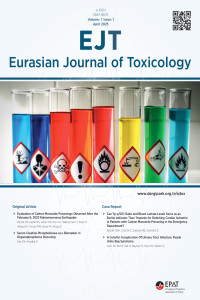Abstract
Background
Organophosphorous poisoning is a common problem in Nepal. Biochemical markers play an important role in the diagnosis and assessment of severity of Organophosphorous poisoning. Presently cholinesterase level which is an expensive biomarker is being used. However, new and cheaper biochemical markers are being studied. The objective of this study was to compare two laboratory biomarkers, creatine phospsokinase and Acetylcholine Esterase and its prognostic significance in Organophosphorous poisoning.
Methodology
A cross-sectional hospital-based study was conducted involving 40 patients with organophosphorus poisoning. Informed consent was obtained from caregivers, and patients of either sex who presented within 12 hours of ingestion/exposure were included. Cases of mixed poisoning, chronic alcoholism, liver/kidney disease, myositis, or use of medications (statins, fibrates, or steroids) were excluded from the study.
Clinical severity was categorized using the Peradeniya Organophosphorus Poisoning Scale. Venous blood samples were collected to measure serum creatine phospsokinase and Acetylcholine Esterase levels. Patients were treated with intravenous pralidoxime and atropine as per hospital protocol, avoiding intramuscular injections. After one week of admission, repeat serum creatine phospsokinase levels were re-measured.
The Pearson correlation coefficient was used to assess the relationship between Peradeniya Organophosphorus Poisoning score and creatine phospsokinase levels at admission, and the paired t-test was used to compare initial and final creatine phospsokinase and Acetylcholine Esterase levels, with a significance level of 0.05.
Results
Majority of patients enrolled in this study had mild Organophosphorous poisoning 32(80%) as per POP score whereas 6(15%) had moderate Organophosphorous poisoning and 2(5%) had severe poisoning. In patients with mild Organophosphorous poisoning the mean initial creatine phospsokinase level was 333.91±182.52 (IU/L). Patients with moderate Organophosphorous poisoning had a mean initial creatine phospsokinase level of 355.40±115.17(IU/L) where as in severe Organophosphorous poisoning the mean initial creatine phosphokinase level was 462.5±279.3(IU/L). The calculated Pearson correlation coefficient of Peradeniya Organophosphorus Poisoning with initial serum creatine phospsokinase level was 0.544 implying distinct positive correlation. The creatine phospsokinase levels in recovering patients showed a tendency to decrease.
Conclusion
Serum creatine phospsokinase level can be used as an alternative marker in the diagnosis and assessment of severity and prognostication in Organophosphorous poisoning. Besides, the fall in the serum creatine phospsokinase level may also be used as marker of recovery.
Key words: Organophosphorus (OP) Poisoning, Creatine phosphokinase (CPK), Acetyl Cholinesterase (AChE), Peradeniya Organophosphorus Poisoning (POP) Scale
Keywords
Organophosphorus (OP) Poisoning Creatine phosphokinase (CPK) Acetyl Cholinesterase (AChE) Peradeniya Organophosphorus Poisoning (POP) Scale
Ethical Statement
Ethical approval was taken from Institutional Review Board of National Academy of Medical Sciences, Kathmandu, Nepal.
Supporting Institution
Bir Hospital, Kathmandu, Nepal
Project Number
069/070/012
Thanks
To all patients who consented to participate in this research.
References
- Balali-Mood M, Balali-Mood K, Moodi M, Balali-Mood B. Health aspects of organophosphorous pesticides in asian countries. Iran J Public Health. 2012;41(10):1-14. Epub 2012 Oct 1. PMID: 23304659; PMCID: PMC3494223.
- Jeyaratnam J. Acute pesticide poisoning: A major global health problem. World Health Stat Q.1990;43:139–44.
- Ravi G, Rajendiran C, Thirumalaikolundusubramanian P, Babu N. Poison control, training and research center, Institute of Internal Medicine, Government General Hospital, Madras Medical College, Chennai, India. Presented at 6th Annual congress of Asia Pacific Association of Medical Toxicology. Bangkok, Thailand: 2007.
- His Majesty’s Government of Nepal. Central Bureau of Statistics, National Planning Commission. Statistical Year Book of Nepal. 2001.
- Gupta SK, Joshi MP. Pesticide poisoning cases attending five major hospitals of Nepal. J Nep Med Assoc 2002;41:447-56.
- Yusuf HR, Akhter HH, Rahman MH, Chowdhary MK, Rochat RW. Injury related deaths among women aged 10-50 years in Bangladesh.Lancet, 2000; 355:1220-1224.
- Sri lankan Ministry of Health. Annual Health Bulletin, 1995. Ministry of Health, Colombo, Srilanka.
- Bhattacharyya K, Phaujdar S, Sarkar. Serum creatine kinase: A probable marker of severity in organophosphorus poisoning. Toxicol Int 2011;18:117-23.
- Agarwal SB, Bhatnagar VK, Agarwal A, Agarwal U, Venkaiah K, Nigam SK, et al. Impairment in clinical indices in acute organophosphate insecticide poisoning patients in India. Internet J Toxicol. 2007;4:1.
- Nermeen A. M. Hassan, Abdelmonem G. Madboly et al. Correlation between Serum Creatine Phosphokinase and Severity of Acute Organophosphorus Poisoning. IOSR Journal of Environmental Science, Toxicology And Food Technology (IOSR-JESTFT): May - Jun 2013: 4(5); 18-29.
- Sen R, Nayak J, Khadanga S. Study of serum cholinesterase, CPK and LDH as prognostic biomarkers in Organophosphorus Poisoning. Int J Med Res Rev 2014; 2:185-189.
- Hernández A F. Influence of exposure to pesticides on serum components and enzyme activities of cytotoxicity among intensive agriculture farmers. Environmental Research. 2006;102: 70–76.
Details
| Primary Language | English |
|---|---|
| Subjects | Clinical Sciences (Other) |
| Journal Section | Original Articles |
| Authors | |
| Project Number | 069/070/012 |
| Publication Date | April 30, 2025 |
| Submission Date | March 24, 2025 |
| Acceptance Date | March 28, 2025 |
| Published in Issue | Year 2025 Volume: 7 Issue: 1 |


